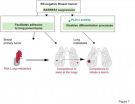(Press-News.org) Sexual inequality between boys and girls starts as early as in the mother's womb – but how and why this occurs could be a key to preventing higher rates of preterm birth, stillbirth and neonatal death among boys.
A team from the University of Adelaide's Robinson Research Institute has been studying the underlying genetic and developmental reasons why male babies generally have worse outcomes than females, with significantly increased rates of pregnancy complications and poor health outcomes for males.
The results - published today in the journal Molecular Human Reproduction - show that male and female babies develop in very different ways, and the placenta plays a key role in these gender differences.
"Our research has found that there are undeniable genetic and physiological differences between boys and girls that extend beyond just the development of their sexual characteristics," says senior author of the paper Professor Claire Roberts, leader of the fetal growth research priority for the Robinson Research Institute.
"We've known for some time that girls are clearly winning in the battle for survival, with markedly better outcomes for female babies for preterm birth, stillbirth, neonatal death, and other complications after birth, such as macrosomia (a baby that weighs more than 4-4.5kg or 8 pounds 13 ounces at birth). Male babies generally grow faster and bigger than females. This occurs in both the animal and human worlds, but until now we haven't really understood how or why," Professor Roberts says.
The researchers investigated whether the type and pattern of genes being expressed by the placenta is different for boys and girls.
They compared the genes expressed in 300 placenta samples and found that more than 140 genes were expressed differently across male and female samples.
"Our results suggest that there is a distinct sex bias in the regulation of genes in the human placenta," says lead author and University of Adelaide PhD student Sam Buckberry.
"We found that with female babies, there is much higher expression of genes involved in placental development, the maintenance of pregnancy and maternal immune tolerance.
"This suggests that girls are more likely to adopt a risk-averse strategy towards development and survival, and it goes some way to explaining the differences in male and female development in the womb," he says.
Professor Roberts says: "These findings may be important to help guide future sex-specific therapeutics for pregnant women and for babies in the neonatal nursery."
INFORMATION:
Media Contacts:
Professor Claire Roberts
Robinson Research Institute
The University of Adelaide
Phone: +61 8 8313 3118
claire.roberts@adelaide.edu.au
Sam Buckberry
PhD student
Robinson Research Institute
The University of Adelaide
sam.buckberry@adelaide.edu.au END
Why are girl babies winning in the battle for survival?
2014-05-27
ELSE PRESS RELEASES FROM THIS DATE:
Medical mechanics
2014-05-27
Removing a malignant tumor from the head of the pancreas is a risky and demanding operation. The surgeon must carefully navigate around the stomach, the gallbladder, the bile duct, lymph nodes, and several high-pressure blood vessels.
But an inexpensive device designed by Harvard engineering students and a surgeon at Beth Israel Deaconess Medical Center offers surgeons a confident grip throughout the delicate procedure. The gentle grasper, equipped with rubberized pressure sensors, has three slender fingers that can slip through a very small incision and tease cancerous ...
Just look, but don't touch: EMA terms of use for clinical study data are impracticable
2014-05-27
The European Medicines Agency (EMA) receives comprehensive clinical study data from drug manufacturers. These data form the basis for the decision on the approval of new drugs. To make this information available to researchers and decision-makers, EMA issued a draft policy in 2013 for the publication of clinical study data, in which extensive data transparency was planned.
Besides other interested parties, the German Institute for Quality and Efficiency in Health Care (IQWiG) was intensely involved in the subsequent consultations. The result of these consultations is ...
The future of sweet cherry in Australia
2014-05-27
AUSTRALIA -- Predicted variations in global climates have fruit producers trying to determine which crops are best suited to weathering future temperature changes. Extreme high-temperature events are expected to become more frequent, and predictive models suggest that the global mean surface air temperature will rise by as much as two degrees by the middle of the 21st century. Higher temperatures could have an impact on the duration of critical "winter chill" periods needed for successful fruit production, potentially altering growing strategies. According to the authors ...
Differences in phenolic makeup of indigenous rose species and modern cultivars
2014-05-27
LJUBLJANA, SLOVENIA – The leaves and petals of roses are valued for their medicinal and aesthetic uses around the world. A new study identified specific phenolic compounds found in the petals of indigenous rose species and compared them with the phenolic profiles of modern rose cultivars to determine differences in the makeup of roses traditionally used for medicinal purposes and those varieties cherished for aesthetic qualities. According to the results, distinct differences exist in the distribution of leaf phenolic compounds, especially between indigenous rose species ...
Researchers identify a new suppressor of breast metastasis to the lung
2014-05-27
A study published today in EMBO Molecular Medicine reveals that the loss of function of the gene RARRES3 in breast cancer cells promotes metastasis to the lung.
The research, headed by Roger Gomis, ICREA Professor at the Institute for Research in Biomedicine (IRB Barcelona), is the result of a collaboration between two IRB labs and Joan Massagué, at the Memorial Sloan Kettering Cancer Center in New York.
The scientists demonstrate that RARRES3 is suppressed in estrogen receptor-negative (ER-) breast cancer tumours, thus stimulating the later invasion of the cancer cells ...
The science of school lunch
2014-05-27
In terms of ambience, Charlotte Central's cafeteria is -- well, conjure up your own elementary school lunch experience. There's more than one reason to run to recess. But on a recent visit to observe a group of researchers from UVM's Johnson Lab, the lunch ladies were serving up something more likely to be found on a restaurant menu: risotto with mushrooms and peas. It's the result of a host of programs by schools around Vermont to offer more tempting choices -- with locally sourced ingredients when possible, including herbs and vegetables from the playground garden -- ...
New University of Colorado study illuminates how cancer-killing gene may actually work
2014-05-27
Scientists armed with a supercomputer and a vast trove of newly collected data on the body's most potent "tumor suppressor" gene have created the best map yet of how the gene works, an accomplishment that could lead to new techniques for fighting cancers, which are adept at disabling the gene in order to thrive.
Scientists from the University of Colorado Cancer Center and the University of Colorado Boulder used a new technology to tease out how the p53 gene—which is responsible for recognizing damaged DNA in cells and then marking them for death—is actually able to suppress ...
Why retailers need to pay attention to the smell of their stores
2014-05-27
This news release is available in French. Montreal, May 27, 2014 — Retail stores overflowing with merchandise can make consumers feel claustrophobic rather than ready to spend. But the recent move towards open, minimally stocked spaces can leave them feeling just as anxious.
The solution to this shopping conundrum may be smell, as new research from Concordia University shows.
In a study recently published in the American Journal of Business, researchers from the university's John Molson School of Business (JMSB) suggest that, when diffused in retail environments, ...
Imaging scientists develop a better tool for tracking MS
2014-05-27
Imaging scientists at Western University's Robarts Research Institute (London, Canada) have developed a better way to track the progression of Multiple Sclerosis (MS) from its earliest stages. Led by Ravi Menon, PhD, the researchers used what's called "Quantitative Susceptibility (QS) Magnetic Resonance Imaging (MRI)," to measure damage in specific areas of the brain which the study showed to be common to all patients. The findings are published in advance online, in Radiology.
"In MS research, there is something we call a clinical-radiological paradox. When ...
Steroids prescribed in the ICU linked to delirium
2014-05-27
New Johns Hopkins research suggests that critically ill patients receiving steroids in a hospital's intensive care unit (ICU) are significantly more likely to develop delirium. Results of their research, they say, suggest minimizing the use of steroids could reduce delirium in the ICU.
While it usually goes away after a few days, studies show delirium in the ICU has a long-term impact. It has been associated with worse functional recovery and cognitive impairments of a magnitude consistent with moderate traumatic brain injury or mild Alzheimer's disease.
Overall, up ...



